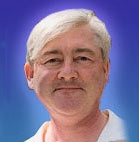Developing effective collaborative knowledge spaces
Account of a NetIKX meeting with
Paul J Corney and Victoria Ward, 18 May 2017,
by Conrad Taylor
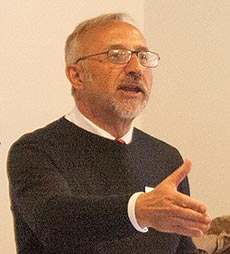
Paul Corney. Photo Conrad Taylor.
During 2017, which is a 20th anniversary year for the Network for Information and Knowledge Exchange, a number of eminent speakers have been invited to lead meetings, speakers who for the most part have addressed NetIKX before. Paul Corney worked for 25 years in top management in the City of London financial sector (Saudi International Bank and Zurich Reinsurance), and for the last couple of decades has pursued a ‘portfolio career’ as a business adviser, facilitator and business coach, with clients in 24 different countries, including Iran, Saudi Arabia, the Gulf States and several African countries.
Paul is also a managing partner at the Sparknow consultancy, which Victoria Ward founded in 1997. Victoria’s background is similarly in knowledge management in the banking sector. Sparknow approaches organisational KM using narrative enquiry methods, and Victoria can list amongst her former clients, a number of banks, government agencies, museums and cultural organisations, the World Health Organisation and the British Council.
Recently, Victoria and Paul have been working with Clive Holtham of the Cass Business School on a project looking at how the arrangement of space impacts the working environment, and knowledge sharing within that. Paul has been conducting a kind of rolling survey across various locations around the world. We in NetIKX would be the latest to add our thoughts; and Paul intends to publish a report as the summation of this enquiry.
Points of view
Paul and Victoria set up an exercise in which the forty or so people present were clustered into three groups, out of earshot of each other. Each group was then quietly told what ‘profession’ we were to adopt as our collective point of view. We were to carefully make an assessment of the room we were in, from that assumed profession’s point of view, and list the positive, and difficult, characteristics of the room. Then each group, through a spokesperson, would tell the others about their list of good or bad room features – and the other groups were supposed to guess that group’s profession!
Group One commented that the room was very white and light; that there were lots of power points. They notes there was quite a lot of furniture, but the tables were on wheels and easily moved; there were lots of nooks and crannies, and lots of potential for mess around the coffee machines. We guessed that they were cleaners! Group Two mentioned the functional design of the room; the low ceiling and narrow form of the room; and lots of natural light from the windows. They were interior designers!
I was in Group Three and I think we had the most fun assignment. We talked about there being a couple of useful exits including a fire exit onto the roof (with presumably a way off that down to street level); various valuables conveniently next to the door, and some rather nice looking IT equipment; perhaps too many windows to be able to operate unseen, but no CCTV cameras. Yes, we were the thieves!
That was a nice, fun ice-breaker, but it was also more than that, as Victoria and Paul explained. Things (and not just rooms!) look different according to your point of view. They had come across this exercise used in a very large gathering at the Smithsonian Museum, and it’s especially useful to deploy at the start of a meeting when you want to draw attention to how a thing, or a situation, might look very different from somebody else’s perspective; something that’s good to bear in mind when there are many stakeholders.
Perspectives on Knowledge Management
KM, or Knowledge Management, has been described as ‘a discipline focused on ways that organisations create and use knowledge’. However, said Paul, beyond that there is no single accepted definition of what KM is, and it’s a field with no agreed global standards as yet.
Paul works around the use of knowledge within businesses. In his newly published book ‘Navigating the Minefield: a practical KM Companion’ he has suggested some characteristics which could define ‘a good KM programme’, such as it being in support of a business’s goals, and aligned with its culture. One focus will be operational, seeking to cut the costs of doing business (in money or time) – in practice, this is the focus of four out of five KM projects in business. Some projects look in more strategic directions, towards innovation and future business benefit.
One paradox of KM is that many of the people who practice it,do not stay long term with their employers, but move on every few years to a new appointment. This can lead to the pursuit of short-term goals and ‘fighting fires’ rather than more strategic approaches.
How can you effectively transfer knowledge from an expert, to a wider community? One positive story Paul shared was of work he did with Cláudia Bandeira de Lima, a leading authority on childhood autism and language development in the Portuguese-speaking world. The solution they devised was to run a foundation programme in the methodology, PIPA (Programa Integrado Para o Autismo), teaching courses and accrediting practitioners.
To represent another aspect of KM, at the personal level, Paul used an image of a laptop. If it is stolen or breaks down, you can replace the hardware and the applications, but if you haven’t backed up the documents which constitute your knowledge resources, ‘you’re toast!’ In doing knowledge audits, he and Veronica often found that sloppy attitudes to managing digital knowledge resources were rampant. An American survey from a few years ago estimated that a typical cost to replace someone in a senior business position is in the region of $400,000 – because when the previous incumbent moved on, they took their knowledge with them, and nobody had done anything to ‘back it up’.
Drivers and definitions
What is driving this thing called ‘knowledge management’? Why do people do it? To Paul it seems that a major driver within many businesses is compliance with regulations; and in a couple of years, when ISO standards for knowledge management appear, it will likely be about compliance with those standards as well. ‘Already today, if you want to sell a locomotive, one of the criteria is that you engage in knowledge management, and are seen to do so in a very professional way,’ explained Paul.
A second driver is around innovation and process efficiency; people believe there is benefit to doing things better with what you have. And a third driver is the management of risk. And then, in some organisations at any rate, there are concerns about using KM to support governance, strategy and vision.
Paul used a simple ‘three pillars’ diagram to represent the above scheme, but his next diagram, giving some examples of motivators/drivers for KM in the real world, was more complicated and so we reproduce it here as an image, with his permission. He represented five different industrial sectors as examples: nuclear power, the regulatory sector, government, industry and the services sector.

Paul Corney’s diagram of ‘macro drivers’.
Reproduced here by permission.
- In the nuclear industry, a key driver is planning for the complex process of decommissioning power plants at the end of their lives. Companies anticipate that when that time comes, they will be downsizing, and at the same time losing people with maybe 40 years of nuclear operations and decommissioning.
- In the regulatory industry (as Paul and Victoria found through interviews in Canada some years back), a large problem is around succession planning as people at the top retire. This is similar to the driver for Shell’s ‘ROCK’ programme (Retention of Critical Knowledge), which they called it ‘The Great Crew Change’.
- In government, ‘flexible working’ has been invoked as a mantra. As Paul and Victoria discovered in interviews at the Department of Justice, a possible effect of this is the diffusion of specialist knowledge, as working becomes more generic. But if this can be managed, services can be improved.
- Enhancing manufacturing processes is a key driver for industry. Paul described a recent three-year project he ran for Iran’s largest company, which aimed to shorten the time it took from coming up with an idea, to bringing it to market.
- In the services sector, including finance and legal work, Paul said that the key to business efficiency is the effective re-use of precedent; it is in this sector that ‘artificial intelligence’ is likely to have the greatest impact.
At this point, Jonathan from Horniman Museum said that he could identify with all those drivers; but in addition, their raison d’être at the Museum is the curation and transfer of knowledge to the general public. Victoria responded that she’d done work about ten years ago for the Museum Documentation Association, funded by the London Development Agency, looking at what museums contribute to the knowledge economy of London. (The MDA shortly relaunched itself as the Collections Trust.) Two things which she remembers well from that project, which were not represented by Paul’s diagram, were:
- As work gets more ‘nomadic’ and fluid, workers in various industries need somewhere they can think of as an intellectual ‘home’; for fashion, it would be the V&A. But when that MDA study was conducted, it seemed that museums were overlooking their rôle in relation to certain professional knowledge networks.
- Knowledge Transfer Officers can play a vital rôle as a ‘cog’ or enabling connector, between the more entrepreneurial innovators in the organisation and those whose instincts are more curatorial and conservative; between ‘fast cultures’ and ‘slow cultures’, if you like.
Co-working hubs
Costs as a driver: Paul referred to a 2013 UK government report on Civil Service reform, authored by Andy Lake of Flexibility.co.uk and called The Way We Work: a guide to smart working environments [http://www.flexibility.co.uk/downloads/TW3-Guide-to-SmartWorking-withcasestudies-5mb.pdf]. This pointed out that the costs of providing working environments, both financial and environmental, can be reduced by switching away from dedicated desks and PCs, to co-working hubs.
Paul hasn’t worked in an office for 20 years – his ‘office’ is just wherever he finds himself with his Mac and his ’phone and other devices. Sparknow had an office for about five years, but the team decided it wasn’t necessary as long as people were disciplined in their collaboration practices. An executive recruitment firm in the USA has offered the opinion that perhaps by 2020, 40% of people will be mobile workers (I presume they refer to office jobs only), and that they will be freelancers. The benefits will be lower operating costs and higher productivity..
With Prof Clive Holtham, Paul has been advancing the view that as these developments occur, organisations will have to ensure that working environments – be they physical like co-working hubs, or virtual like arrangements for remote working – will be conducive for effective Knowledge Management. (This is what we were going to be looking at for the rest of the day.)
Finally, there was about 20 minutes left. Rather than having some kind of delegated report-back from the table groups, as many might do, Ron improvised another Gurteen-like feature: he asked the groups to reflect on the process they had experienced and what they had learned from it; then half way through, asked half the people at each table to move to the next table and continue the same discussion.
Victoria Ward noted that when they first started doing Knowledge Audits, people never included looking at their ‘knowledge spaces’. They would look at their networks, their disciplines, but it always surprised the clients when they were asked how the physical workspace functioned. When asked to conduct a Knowledge Audit, they now ask to take a look at such spaces, and ask questions about how they are supported.
Good and bad knowledge spaces
‘Did you know that the average desk is occupied for only 45% of office hours?’ asked Paul. That’s what Will Hutton noted for the Work Foundation in 2002, in a report for the Industrial Society. The foundation claimed that the workplace (the office workspace, that is – not fields and factories, shops and warehouses) was being reinvented as ‘an arena for ideas exchange’ and a drop-in workspace for mobile workers: a place where professional and social interaction can occur. And the foundation noted that workspaces which are badly designed or badly managed can actually damage the physical and mental wellbeing of staff.
The firm of Ove Arup believes that the future of (office) workspace will be a network of locations – many of them on short leases or even pay-as-you-go, shared spaces rather than highly ‘territorial’ ones. Also, they believe there will be a corresponding flexibility in working interactions, operating across both physical and virtual environments.
The Edge. In January 2017, Paul was helping to run some events around the KM Legal conference in Amsterdam. At a Smart Working summit in 2016, Paul had heard of an amazing office building in Amsterdam called ‘The Edge’, so on this trip he made a visit to the place, and was shown around by the architect and the building manager. The building’s developer was OVG Real Estate and the design was by London-based PLP Architecture. The building’s main tenant is the consulting firm, Deloitte.
There is a video about the place on YouTube – at https://youtu.be/JSzko-K7dzo – and Paul showed it to us. (There is also a Bloomberg article at https://www.bloomberg.com/features/2015-the-edge-the-worlds-greenest-building/)
The video claims that The Edge is ‘certifiably the greenest building in the world’, with its extensive use of natural light, and harvesting of solar power (the building is a net producer, not consumer, of electricity). Heat pumps circulate water through an insulated aquifer over a hundred metres below, to warm the building in winter and cool it in summer. From the viewpoint of our meeting topic, however, what is significant is how it is structured as a place for a new way of productive working, what the Dutch call het nieuwe werken.
Nobody gets a desk of their own at The Edge; Deloitte’s 2,500 workers there share 1,000 ‘hot desk’ locations, and can also access tiny cubicles or shared meeting facilities, some with massive flat screens which sync with laptops or mobiles. Workspaces are assigned to you according to your schedule for the day, and your ‘home base’ is any locker which you can find empty for the day.
Access to these facilities is driven by a smartphone app used by every worker, and a system which notes everyone’s location and needs and preferences and adjusts the local environment based on your preferences; this is supported by a distributed network of 28,000 sensors.
Paul also commented that people do really want to come to work at The Edge – that’s been a driver of recruitment, there is little absenteeism, and it is somewhere clients want to visit too. Another thing that users of the building repeatedly praise is the use of natural daylight, which supplies 80% of lighting needs (including through a huge central covered atrium).
Ellipsis Media is a successful content management company, which started above a toy shop in Croydon. They used to have meetings around a particular table in the pub opposite, and as they grew into new premises, they bought that table and installed it as their own little bit of history. Paul mentioned other instances of companies (HSBC, Standard Chartered) using their office space to curate their history – the history of their internal community and its journey.
BMS. Paul also described his engagement with the world’s largest reinsurance broker, BMS, which used the opportunity of their move to One America Square near London Fenchurch Street station. The move brought 13 different federated business units into one shared location. As part of the move, BMS created collaborative physical spaces, including a meetings hub called ‘Connexions’ and an adjacent business lounge with the very best coffee, subsidised snacks and high-speed mobile Internet access. This had a great effect in helping people to break out of the silos of the formerly isolated business units (see Paul’s account of BMS’s journey at http://www.knowledgeetal.com/?p=465).
KHDA. During 2016, on his way back from Iran, Paul went to see friends in Dubai. The Dubai Knowledge and Human Development Authority (KHDA) manages secondary and higher education in Dubai. He showed us pictures of their open-plan workspace – you’ll often see the Chief Executive sitting there. It’s a very informal place – Paul even had a budgerigar fly past his head!
Asian Development Bank. Victoria and Paul worked together (as Sparknow) in Manila, on a project for the Asian Development Bank. ADB’s shared atrium space at the time included a touchcreen with a huge Google Earth display. Victoria added that ADB had long had a traditionally styled library, but had remodelled it, moving the bookshelves to the edge and creating an open central space. The Google map was put there, and used as an ‘attractor’ to cause people to slow down and encounter each other, to cut across the boundaries in the organisation. ADB used the space for a number of knowledge-sharing events, including ‘Inside Thursdays’.
ADB got Paul and Victoria to run a three-day workshop in that space, exploring the use of narrative in the ADB. They were able to construct a temporary collaborative knowledge space, with a long timeline laid out over connected tables, and workstations at which participants could mark out a map of the ADB’s history, and their hopes for its future – and to identify where interviews should be conducted with the oral history practitioners, and what kinds of questions should be asked.
That event was very memorable for its visual components, too. That pop-up knowledge space, and the shared creation of the timeline and other artefacts, created a useful and engaging memory for people when they then looked later at the products of the knowledge work.
ADB has published a paper about this in 2010, called ‘Reflections and Beyond’ (184 pages) which can be retrieved as a PDF from http://reflections.adb.org/wp-content/uploads/2014/08/adb-reflections-and-beyond.pdf. There is also a concise Sparknow narrative about the project at http://www.sparknow.net/publications/ADB_Reflections_Beyond_method.pdf.
Exercise set-up: the Knowledge Space Survey
Before we took our refreshment break, Paul gave a little background to a rolling project he has been co-ordinating, called the ‘Collaborative Knowledge Space Survey’. This qualitative enquiry had already gathered contributions, some by email, and some at events such as at a Masterclass he ran in March at the International Islamic University of Malaysia in Kuala Lumpur. Now it would be NetIKX participants’ chance to contribute!
Paul’s collaborators in collating and reviewing the results are Prof Clive Holtham and Ningyi Jiang at Cass Business School.
Ron followed this observation by some stories about how the COPD patients have been benefitting from the drop-in sessions, and how much they valued it.
To capture people’s ideas about ‘knowledge spaces’ at work (both physical and virtual ones), the survey has ten set questions, but the answers could be open-ended, in textual and often narrative form. There were certainly no multiple-choice answer mechanisms.
Around the walls of the room in which we were meeting, nine posters had been set out, each one with one of the survey questions (except the first question, ‘Which continent do you work in?’), and the space below left blank in readiness for our contributions. Paul asked us to peruse the questions during the break, and choose which of them we would personally like to work with. The nine remaining questions were:
- Question 2 — Where do you have your most interesting work conversations and do your best work?
- Question 3 — Do you think your own workspace encourages collaboration? Tell us about a recent incident where this happened and who was involved.
- Question 4 — Are there any parts of your building or workspace which you associate with memorable moments of work? Tell us about a time and place when this happened.
- Question 5 — How does where you work reflect the way you work?
- Question 6 — Have you ever witnessed a company change its physical workspace radically? What happened?
- Question 7 — What you you understand by the term ‘digital workspace’?
- Question 8 — In your experience, can you now replace physical workspace with a digital workspace? If so, how? If not, why not?
- Question 9 — Does your organisation have a workspace strategy, and if so does it include a digital workspace? Please tell us about it.
- Question 10 — ‘Any Device, Any Time, Anywhere’ is how one organisation now defines its approach to remote working. Looking forward to 2020, what changes do you foresee in the way you work and the devices you will be using?
Each of us should gravitate towards the question that interests us most, and an ideal group size would be 4–6 people. Grouped around our question of choice, we should consider, is there a pattern or theme that we might use in a checklist? And what keywords might we use to ‘tag’ the responses which we chose?
The exercise process
The way our NetIKX group approached the Collaborative Knowledge Space Survey is not the only way it can be done. For a start, the way we assigned ourselves to particular questions meant that by and large each person contributed to thinking about only one of the nine questions – even though Paul declared the Open Space ‘law of two legs’, and we could have moved from one group to another. But the separate group discussions went well in the 30–40 minutes available.
Nobody was attracted to Question 4, and for obvious reasons Question 1 was off the table. Thus we collected reactions to eight out of the ten survey questions. It is decades since I had anything like a ‘regular job’ and worked in a workplace, so I chose to work in the group clustered around Question 8.
After we had filled our posters, Paul prompted each group in turn to share thinking with the rest of the room. You can see the posters themselves which Paul afterwards embedded as images within the slide set, and accompanying this blog post. I also took my recording gear with me around the room to capture what people said in more detail.
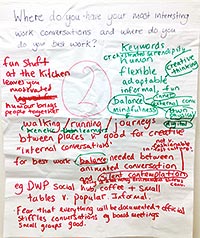
Q2: Where do you have your most interesting work conversations, and where do you do your best work? — This group discussed the value of having both quiet places and busy places. Melanie described the Hub at DWP, which is a large area with a coffee bar and lots of different tables. On the poster, the group had noted that humour and banter, for example around the kitchen, brings people together and leave you feeling motivated. When you’re on a journey, on a train, even just walking between places, this has value in freeing up ‘internal conversations – you often need silence ‘so you can hear yourself think’.
The keywords the group chose were human – flexible – adaptable – informal – fun – balance (between external and internal conversation, and between physical and digital) – mindfulness. Emma added that the most interesting and significant conversations are usually in an informal setting, and are often serendipitous.
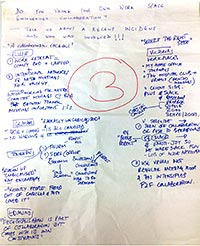
Q3: Do you think your own work space encourages collaboration? — This group had started by comparing their own workspace experiences. Lissi referred to her ‘collaboration cocktail’ of spaces, ranging from attending NetIKX meetings to sitting up in bed to do her work. Victoria Ward had a range of spaces and reported positively on ‘Slack’ (slack.com) , a cloud-based service which describes itself as ‘real-time messaging, archiving and search for modern teams’ (it’s an acronymn for ‘Searchable Log of All Conversation and Knowledge’!)
Graham Robertson works largely alone and his workspace is a room with no windows. ‘Radical uncubicalisation’ was a phrase that came up from two organisations which are trying to draw people out of their cubicles. Edmund Lee (Historic England) said that when people get a taste of this, they love it, but you need other kinds of constraint in place to make things happen.
Collaboration, said someone, involves interaction between human and human, also human and information. Information has its own kind of structure around the workplace; but humans, it must be remembered, have other goals in life, even when they are at work: getting on with people, getting something to eat, whatever.
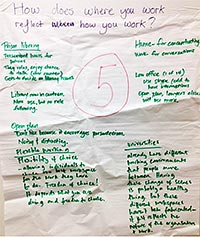
Q5: How does where you work reflect how you work? — Naomi Lees (DWP) said that the culture that you work in reflects the physical aspects of where you work. For example Ayo Onotola is a librarian who works in a prison. (It is a compulsory requirement for every prison, to have a library, as part of the process for the reform and rehabilitation of the inmates.) He said, it may surprise people to know that quite a proportion of the prisoners are illiterate; and many don’t have English as their first language; so the prison runs a number of educational programmes for them. The library is key to that.
But – when you work in a prison library, it is a bit like being a prisoner yourself! When there is some trouble in the prison, there may be a general lockdown, then nobody comes to the library all day. Prisoners’ behaviour in the library is quite different from how they behave in their cells; ‘they see the library as a cool place to come and chill out’, Ayo said. And they are keen to collect books to take back to their cells. (On the poster, there was a note that recently the library has been moved to the canteen space, and is now getting more use.)
David Penfold’s example was the university, which has many different possible work environments and people – staff and students both – move between them and find those that are most conducive to what they want to do right now. And people also do much of their work from home.
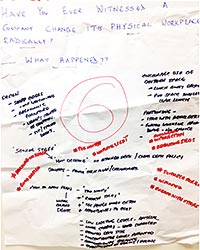
Q6 — Have you ever witnessed a company change its physical workspace radically? What happened? — ‘Hot desking’ inevitably came up within this group; one person spoke of a transformation to open plan, hot desking and a clear-desk policy, including senior managers. Yes, there was resistance to this at first, but people have come to realise how working together in this way has encouraged the sharing of ideas quite naturally through conversation. It has to be said that the facilities provided were very good. Prior discussion with the users had raised the need for spaces for private conversation, and they had been provided. There are also ‘meeting pods’ set in the middle of the canteen area.
Good space design is crucial, said another person. Consultations with staff in advance is the key. When he worked at the Department of Energy and Climate Change, they had discovered that often there were serendipitous meetings in lifts that then continued to an adjacent space to continue. In another job, at a research institute, staff had been worried about the place becoming too noisy for concentration; this was met by setting up booths with acoustic shielding, for study or for private conversation.
Canteen spaces are particularly ripe for creative use, and that goes well with a culture that encourages people to take lunch away from their desks. (I remember that when I was doing a series of training workshops at Enterprise Oil, their staff canteen provided lovely food free of charge, which was certainly a motivator in that direction!)
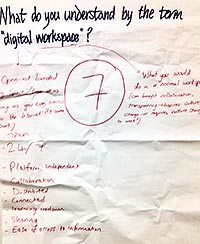
Q7: What do you understand by the term ‘digital workspace’? — This group understood a digital workspace to be something that was open and without boundaries, both boundaries of physical space and time, able to operate 24 hours a day, seven days a week. They noted that this requires broadband that is fast enough. It should enable you to do what you would do in a ‘normal’ or ‘standard’ workspace, but allows for collaboration and the sharing of information.
Paul referred to work he had done in Africa, where there is usually very poor access to the Internet. But people adapted to that by communicating via WhatsApp – short, asynchronous conversations that can be picked up again after a communications breakdown.
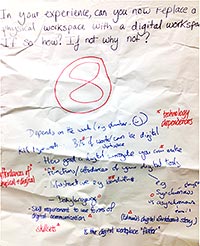
Q8: In your experience, can you now replace a physical workspace with a digital workspace? If so, how? If not, why not? — This was the group I was in, with Edmund Lee, and the first thing we decided was that the afternoon’s conversation had had an unspoken bias towards office-type work. If you are a plumber, a farmer or construction worker, a social worker or a surgeon, a shop assistant or other front-line customer service worker, what you can achieve in a digital workspace will be strictly limited. So no, you cannot replace physical workspaces with digital ones, except in some narrowly defined fields.
For most of those at today’s event, a so-called digital workspace can substitute for many aspects of the physical workspace, but that is dependent on how good a digital surrogate you can create to replace the physically of that with which you work. Edmund works with archaeological excavations, and he noted that before you can consider implementing a digital workspace for such work, you have to find a way to make a digital surrogate of the things you work with. An example would be an expert in Roman pottery who has access to the physical artefacts, but nothing more than a digital representation of the site where they were found.
Another issue is the functionality and ‘affordances’ of the digital tools available. There are bandwidth and infrastructual constraints, and there are human factors. When conversations take place over a digital medium, can they convey body language? Paul agreed that is a huge issue, and he had just been running a workshop with Chris Collison on improving work in virtual teams and communities.
There are also new skill requirements and support issues. Edmund told of how their IT department had installed large digital whiteboards in the main meeting rooms, but didn’t tell anybody how to use them. So, the technology worked for the IT department but for nobody else!
Q9: Does your organisation have a workspace strategy and if so, does it include digital workspace? — This did not result in a poster, but Malcolm Weston reported on their successes at Aecom, which now has grown (by a process of acquisition and amalgamation) to 187,000 employees across 150 countries. That process required workspaces to be brought together, and collaboration between the business units to be enhanced. And so Aecom did set out a formal workplace strategy, to be implemented in every office worldwide.
The implementation in London involved internal change management consultants, and interior design consultants, talking to different teams within the organisation asking them what they liked about their current workspace environment, and what they didn’t like, and what they wanted changed. The new environment was created in the offices in Aldgate Tower.
Aecom staff now work in ‘neighbourhoods’, with the colleagues in their team, though not always at the same desk. Teams which would naturally want to collaborate on delivering work are situated adjacent to each other. There are internal staircases between four of the floors, with open plan breakout areas around them all. There are also small ‘walled sofas’ suitable for taking part in a conference call, meeting rooms which can be booked via a phone app, through to a small lecture theatre. No-one has a fixed computer; everyone has a mobile phone and a laptop; there is secure WiFi. You can also work from home via the VPN.
One of the drivers was to improve customer satisfaction; another was to avoid costly redesign by getting things right through collaboration, first time around. It also meshed with Aecom’s collaborative selling initiative; clients like to come and have meetings at Aecom’s place.
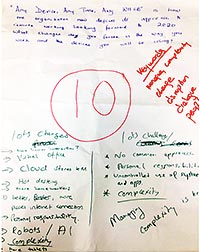
Q.10: Looking forward to 2020, what changes do you foresee in the way you work and the devices you will be using? — This team described a Lloyds Bank demonstration of virtual presence, using a VR headset. They thought one of the challenges of the future might be the emphasis on self-service, and the variety of devices, and perhaps a decentralisation of information storage. The team chose ‘change’ and ‘disruption’ and ‘managing complexity’ as key phrases.
Steve Dale spoke of having recently finished some work for an international organisation spread across thirty countries. Their policy is ‘extreme BYOD’ (bring your own device – no rules at all about what equipment or software to use. They did an audit, and discovered sixty different systems in use. And there were concomitant problems – a lack of collaboration across teams, and how the hell do you find Stuff? They did interviews between stakeholders, and discovered a split between people who like this freedom, and others who flounder in this lack of structure (particularly people newly joining the organisation).
Wrapping up
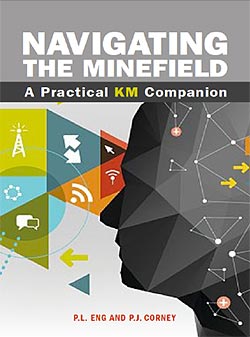
Navigating the Minefield by Paul Corney and Patricia Eng: for details and how to purchase this book, visit Paul Corney’s web site.
Paul skipped a number of his slides, which review the survey responses from Lisbon, Kuala Lumpur etc. A couple of slides also pulled out some of the insights which are beginning to emerge in the analysis Paul is doing with Clive Holtham and Ningyi Jiang at Cass Business School.
Paul referred to a meeting he and Victoria had recently had with Neil Usher at BSkyB. Neil has a twelve-point checklist: Daylight – Connectivity – Space – Choice – Control – Comfort – Refresh – Influence – Storage – Colour – Wash – Inclusion. Paul didn’t have time to unpack what these mean; apparently they are explained on Neil’s blog (http://workessence.com/). The two most important aspects, according to Neil, are natural daylight, and giving people choices.
Paul finished the afternoon workshop drawing attention to some closing slides which give contact details for himself and for Victoria.
Paul J Corney – paul.corney@knowledgeetal
On Twitter: pauljcorney
On Skype: corneyp
On mobile: +44 (0) 777 608 5857
Victoria Ward — victoria.ward@sparknow.net
A further note on resources
The agreement between Paul Corney and NetIKX is that his slide set (Powerpoint rendered into PDF) will be made available only to those who are paid-up NetIKX members; which is why I provide no link here. Go here to learn more about NetIKX individual and corporate membership and its benefits.
A personal thought on ‘digital’ vs ‘virtual’
Paul and Victoria contrasted physical spaces where people meet and converse, and digital ones. I would prefer a contrast between physical and virtual spaces. My reason is, that I wish to give the nod to old traditions of knowledge sharing which used correspondence and publication — instances of which are the so-called Invisible College. Collaboration minus face-to-face did not need an electronic medium to get started; it required shared language, writing, and a means of sending messages.
